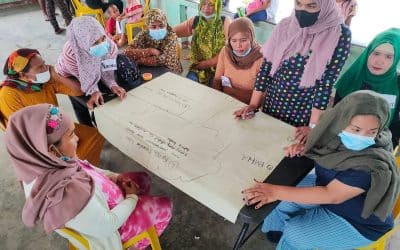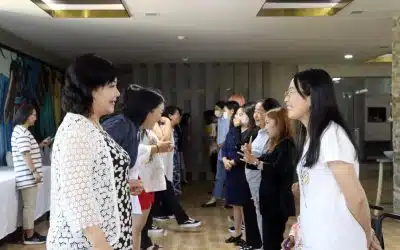InAsia
Insights and Analysis
Green Tea and Recycled Cardboard: Living on the Periphery of Urban Planning in Hanoi
March 18, 2020
To our readers: As the COVID-19 emergency unfolds around the globe, the health and safety of the communities where we work is our top priority. As we protect and care for one another, we are working hard with our partners, grantees, and staff to continue the Foundation’s important programs in Asia. We will also continue to bring you InAsia during this challenging time, knowing that readers may be more interested than ever in news of our world.
Tien—not her real name—moved to Hanoi 10 years ago from Nam Truc District in northern Vietnam. She had no choice, she says. Her village used to be primarily agricultural, and she and her husband owned some decent-sized paddy fields from which they subsisted and sold some rice. But when the garment factories arrived a decade or so ago, the local economy changed. Her husband developed health problems and could no longer work. Young adults like her three children could get jobs in the new factories, but Tien was deemed too old. With no other prospects, she moved to Hanoi in search of work. Her husband stayed behind in the village, where he now looks after their four grandchildren and takes them to and from school each day while their parents work.
Asia has enormous urban populations. An estimated 2.3 billion people live in Asia’s cities, and the UN predicts this number will grow to 3.5 billion by 2050. Vietnam, together with Bangladesh, Pakistan, the Philippines, and China, is at the forefront of this urban explosion. As birth rates fall, much of this urban population growth comes from migration from rural areas.
The consequences for migrants are both positive and negative. Among the positives are economic opportunity and a broader network of social connections. The concentration of people in metropolitan areas, however, also leads to disproportionately high levels of violence, crime, and poverty. Marginalized populations in cities suffer deprivations due to lack of affordable housing, limited or unsafe public transportation, insecure and frequently exploitive employment, air and water pollution, and poor or inaccessible public services.

Many urban migrants in Hanoi are part of the informal economy, supporting themselves with small street stalls and recycling cardboard from local offices. (Photo: Nicola Nixon / The Asia Foundation)
Tien is part of this trend, one of approximately 13 million internal migrants in a country of 94 million. In Hanoi alone, internal migration is adding around 300,000 residents each year to a city of 8 million. Working in and around Hanoi’s central business district, Tien alternates between looking after a small stall selling green tea and sweets, cleaning local office spaces on call, and collecting paper and cardboard from the same offices to sell for recycling. It’s tough work, and highly insecure. She is one of the thousands of migrant women who eke out a living in the busier parts of the city, selling produce by the side of the road and doing odd jobs.
While some of her cleaning jobs are relatively stable, Tien says there is less and less paper to collect as office work becomes more automated and moves online. There is also growing competition for the meager recyclables still produced. Earning around $150 a month, she currently has enough to support herself and to send some money home, but she doesn’t expect it to last. She points to the small pile of flattened cardboard boxes she has collected this morning. It’s much smaller than it used to be, she tells us.
Tien is fortunately not alone. She has developed a community of 30 to 40 women around the same age and from the same village, which provides her with a tight network of support. With two of her friends, she rents a small room near the city center, 15 square meters, for $60 a month.

Three street vendors, likely urban migrants, pause for a moment to socialize in a busy day of fruit and vegetable selling. (Photo: Nicola Nixon / The Asia Foundation)
She says her circumstances are better than some. Others she knows from Nam Truc District are living in squalid conditions in a suburb near Long Bien Bridge in the east of the city. Most of the residents there are also internal migrants, from all over northern Vietnam. Although migration to cities helps the rural poor find new jobs and social services, urban poverty is also a constant presence. Women are particularly vulnerable to safety and security risks in urban environments.
Tien and her compatriots also represent the growing proportion of women to men among internal migrants in Vietnam. Patriarchal social norms mean older men, as “family heads,” more commonly hold positions of power in local communities. Women like Tien and her friends are more likely to shoulder the burden of migrating to find work when times are tough. Women now make up the majority of those leaving rural areas, many of them moving to the city on their own.

Many street vendors are on the move, loading up bikes with their wares to reach more potential customers. (Photo: Nicola Nixon / The Asia Foundation)
The circumstances of Tien and others like her receive little attention from municipal authorities beyond the regular efforts to get informal street sellers to “move along.” Prof. Pham Thuy Loan, vice-director of the National Institute of Architecture, notes that very few issues of vulnerability or marginalization are considered in orthodox urban planning in Vietnam, which tends to focus solely on the technical dimensions of zoning. The lack of data on how different groups use urban spaces is a major obstacle to more inclusive planning, she says, and more research is needed on the social dimensions of cities, especially the informal sector. Recent advocacy for “integrated planning” has placed more emphasis on environmental impact, but “social impact,” such as the impact of planning on vulnerable groups whose workplace is on the streets, still receives little attention.
With 80 percent of internal migrants falling between the ages of 18 and 39, and many of them well educated, Tien’s age and limited education put her in a particularly vulnerable minority that struggles to compete for employment opportunities. She would much prefer to be back in the village, but she doesn’t much dwell on the thought, as it is just not an option.

A moment of tired trepidation from a street vendor selling soup. (Photo: Nicola Nixon / The Asia Foundation)
We chatted with Tien for an hour or so on a chilly day in December, each of us with a cup of green tea, perched on small plastic stools next to her friend’s street stall. Tien is unsure what the future holds. Worried that her job opportunities are drying up, she plans to give it a few more years and then return to her family in the village. As she speaks of what’s to come, her expression is hard to read. Perhaps she prefers not to think that far ahead.
With support from Australia’s Department of Foreign Affairs and Trade, The Asia Foundation is putting gender and inclusion at the heart of its work on urban governance, with a view to an international learning event in the region later in 2020.
Nicola Nixon is director of governance, and Tran Chung Chau is a regional program officer, for The Asia Foundation’s Program Specialists Group. They can be reached at [email protected] and [email protected], respectively. The views and opinions expressed here are those of the authors, not those of The Asia Foundation.
About our blog, InAsia
InAsia is posted and distributed every other Wednesday evening, Pacific Time. If you have any questions, please send an email to [email protected].
Contact
For questions about InAsia, or for our cross-post and re-use policy, please send an email to [email protected].The Asia Foundation
465 California St., 9th Floor
San Francisco, CA 94104
The Latest Across Asia
News
April 25, 2024
Program Snapshot
April 18, 2024
News
April 17, 2024

2024 Lotus Leadership Awards
Thursday, April 25, 2024, New York City
The Lotus Leadership Awards recognize contributions towards gender equality in Asia and the Pacific







0 Comments